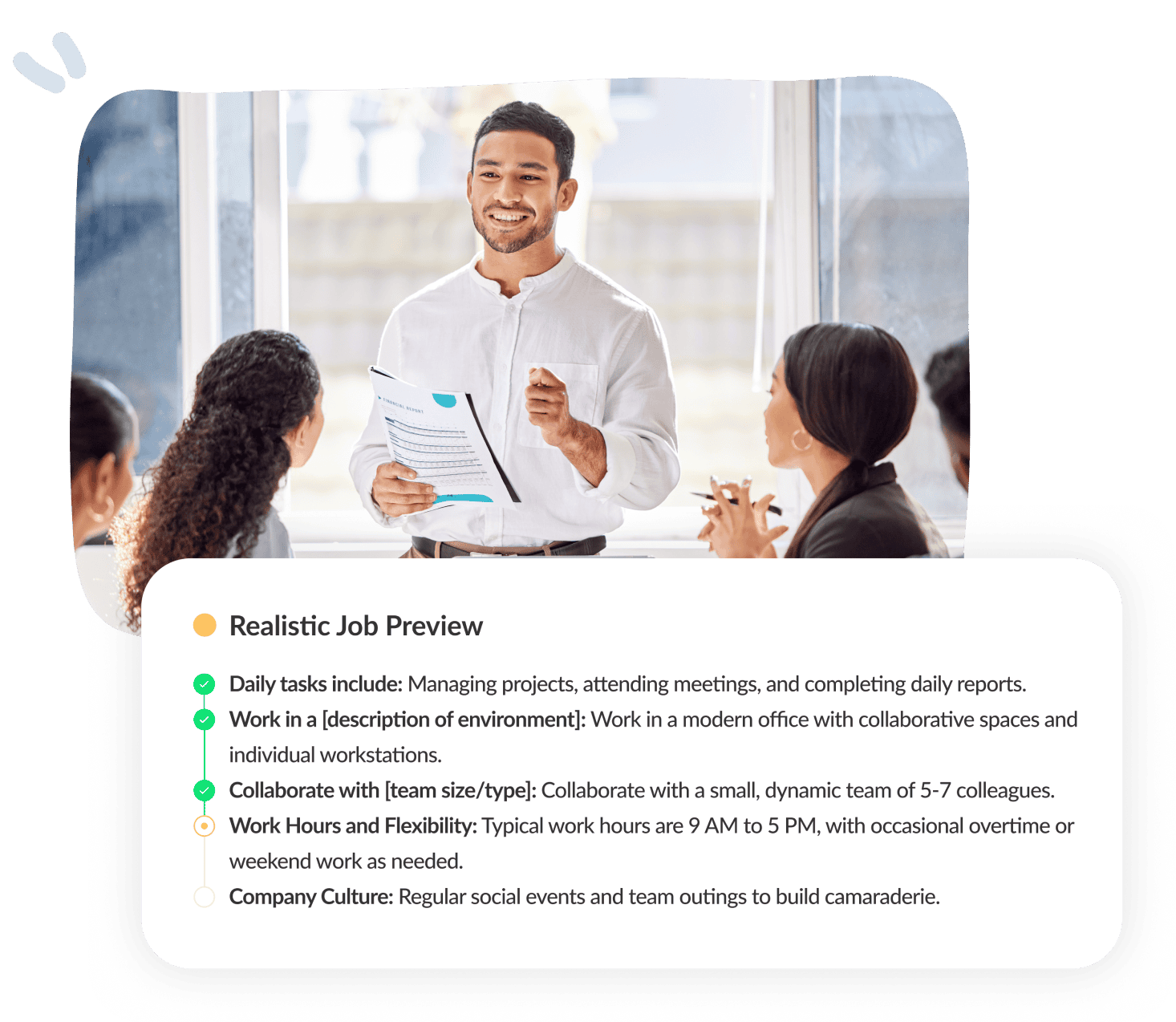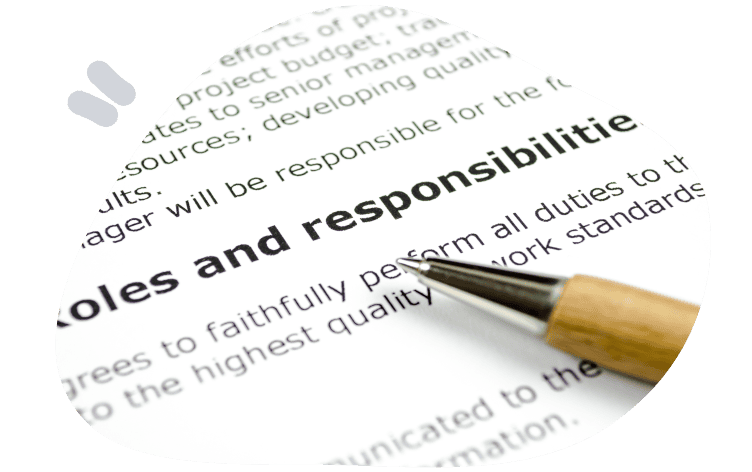
Use Exit Interviews To Improve Hiring
Learn how to get valuable insights to reduce turnover, improve the employee experience, and hire better.

One of the most common reasons why companies lose out on high-quality talent is that the job duties and scope of work did not properly match the job description. Particularly for top talent, early turnover is exceedingly likely if new hires feel the job doesn’t match with what they were told before they were hired. Companies can help mitigate this issue by giving job candidates a realistic job preview before they’re hired.
With a realistic job preview, job candidates receive a more accurate view into what their role will look like if they are hired. Not only does this provide more transparency and boost interest on the part of candidates, it can also help ensure that candidates who are hired for the role are capable of more quickly onboarding.

A realistic job preview, or RJP, is one in which a job candidate gets to see what their job will look like with more clarity, instead of having to rely on a job description. For many office-centric jobs, or those that are fully remote or with hybrid work schedules, potential new hires may not get a chance to see what their day-to-day role will look like. Quite often, they have to rely on the job description and promises made to them during the interview process.
That requires a significant amount of trust on the part of job applicants. How applicants are introduced to the role prior to being hired will make a large impact on their desire to stay in the short and long term.
According to a survey from TheMuse, 72% of workers felt either “surprise or regret” after starting their new role.
While the ideal situation for any company is to have new hires pleasantly surprised that their role, and the company, are better than expected, the opposite frequently happens, instead. Many workers find a mismatch between their expectations and many aspects of the job, including role responsibilities, team or company culture, and benefits. Offering applicants a realistic job preview can significantly help mitigate what TheMuse calls “Shift Shock.”
There are many realistic job preview examples that companies can use to create a better hiring experience for job candidates. Different strategies may include:
There are also multiple ways to provide realistic job previews within each of these contexts, including in-person, remotely, or through generated content such as slideshows or videos.
There is, of course, some risk involved for the employer. With an RJP, top-choice candidates may see the negative sides of the role or company before being hired and choose not to proceed. Nevertheless, that’s a far better and less costly outcome than early turnover.
A group-based realistic job preview is an efficient way to help potential job applicants or multiple individuals who have already applied decide whether the role is right for them. Using this process, companies can present detailed information to a group of applicants at the same time. Following that session, or even using multiple stopping points, participants will have the opportunity to decide whether they’ve “seen enough” and want to drop out of the application process, or proceed with applying for the role.
This is a great way for employers to help applicants self-select without incurring a lot of time and expense on the part of the business. Ultimately, that’s a better outcome for both the applicants and the employer, as it results in a much closer match between the wants and needs of both parties involved.
Example: A marketing company may have a group RJP where applicants participate in a brainstorming session with the existing marketing team.

Pre-application RJPs focus solely on individuals who have not applied for the role. These individuals will usually be sourced by recruiters, who invite each individual to either a personal or group-based RJP. When applicants are sourced via recruiters, a pre-application RJP can lead to much higher quality candidates who are more likely to apply and accept the role.
Example: A manufacturing company could post a video on its career page that provides a view into workers engaging in their daily activities within one of its facilities. The video could include interviews with current employees talking about what they do, how they do it, and why they continue to work for the company.

Structured observations allow potential new hires to see what their role would be like in real-time. This has the distinct benefit of being more immersive than a video or presentation, and gives job candidates a better sense of what it feels like to engage in the work.
Example: A customer service role at a retail store may include applicants observing how current associates interact with customers during the busiest time of the day.

There are multiple different ways to create effective RJPs. The type of RJP a company decides to use will depend on the company’s industry, role it’s hiring for, number of potential and current applicants, and the desired outcome of the RJP.
That said, there are some best practices that apply to almost every RJP, regardless of those factors:

The goal of a realistic job preview is to give potential and current applicants an effective introduction to the company and their role. Successful RJPs are not ad-libbed. Instead, they’re structured and planned, even when it’s a walkthrough or live preview of the work.
Consider creating an implementation checklist that follows a structure similar to this one:
Have a clear outline of the purpose and your target audience.
Consider what will be most valuable to applicants (job duties, responsibilities, culture, team dynamics, etc.).
Create the plans, scripts, and presentations outlines, etc., that you will show to your applicants.
Choose how you will deliver your RJP, e.g., virtually, in-person, or using a hybrid approach.
Decide who on your team will be responsible for different parts of the RJP.
Decide how you will measure the success of your RJP. Depending on your delivery method, this could include the number of applicants you receive, quality of applicants, time-to-fill, new hire turnover rates, or employee satisfaction surveys.
Get feedback from RJP participants to learn how to improve the process. Then, implement the changes that will positively impact the outcome of your job previews.
The goal of job previews is to produce better hiring outcomes. If the structure is well-planned, it will likely bear good results.

Realistic job previews add an extra step to the hiring process for both applicants and employers. While it adds some additional work on the side of the employer, it can result in several important benefits for companies that effectively utilize this strategy.
These benefits aside, a realistic job preview may not be for every company. An RJP may reduce the number of people who apply for a role if the more clarified details of the job turn people away. There may be times when it’s necessary for your company to have more applicants and have the opportunity to clarify the details of the role more personally and in a way that an RJP could detract from.
Nevertheless, the best strategy may be to choose your RJPs wisely. Pay attention to the exit interviews from your employees who quit, especially those who quit early after their initial hire. These will help inform you whether certain roles are better served with an RJP, and what type or job preview would work best for that role.

A realistic job preview offers several advantages for both employers and job applicants. For employers, it can reduce turnover rates, and positively impact the company’s reputation as an honest and transparent employer. For candidates, it helps mitigate job shock, manages expectation, and increases job satisfaction thanks to more clarity on the role and company culture.
An RJP should be as honest and transparent as possible. Still, employers should find a way to balance the good and the bad aspects of the role. Present challenges as opportunities for growth and development. For example, instead of saying “the workload is heavy,” a company could say “the role provides many opportunities for rapid and visible growth and development.”
You should update your realistic job previews as frequently as necessary. When and how often you update depends on what changes are occurring within the role and the company. Generally, it’s a good idea to review your RJPs annually, and weigh the content against what’s currently true about the role and the company. Adjust as needed.
Modernize your hiring process with expert insights and advice.